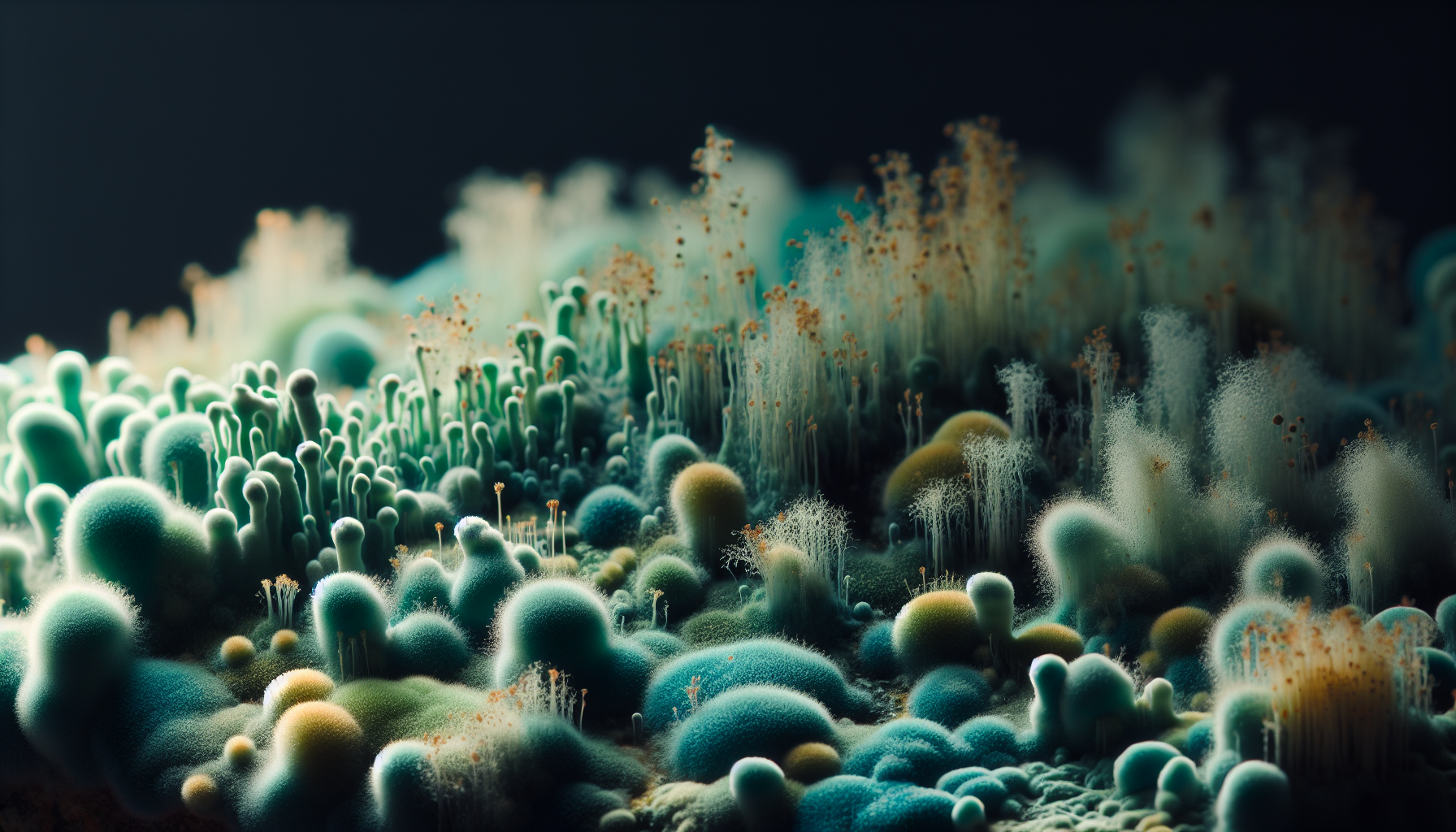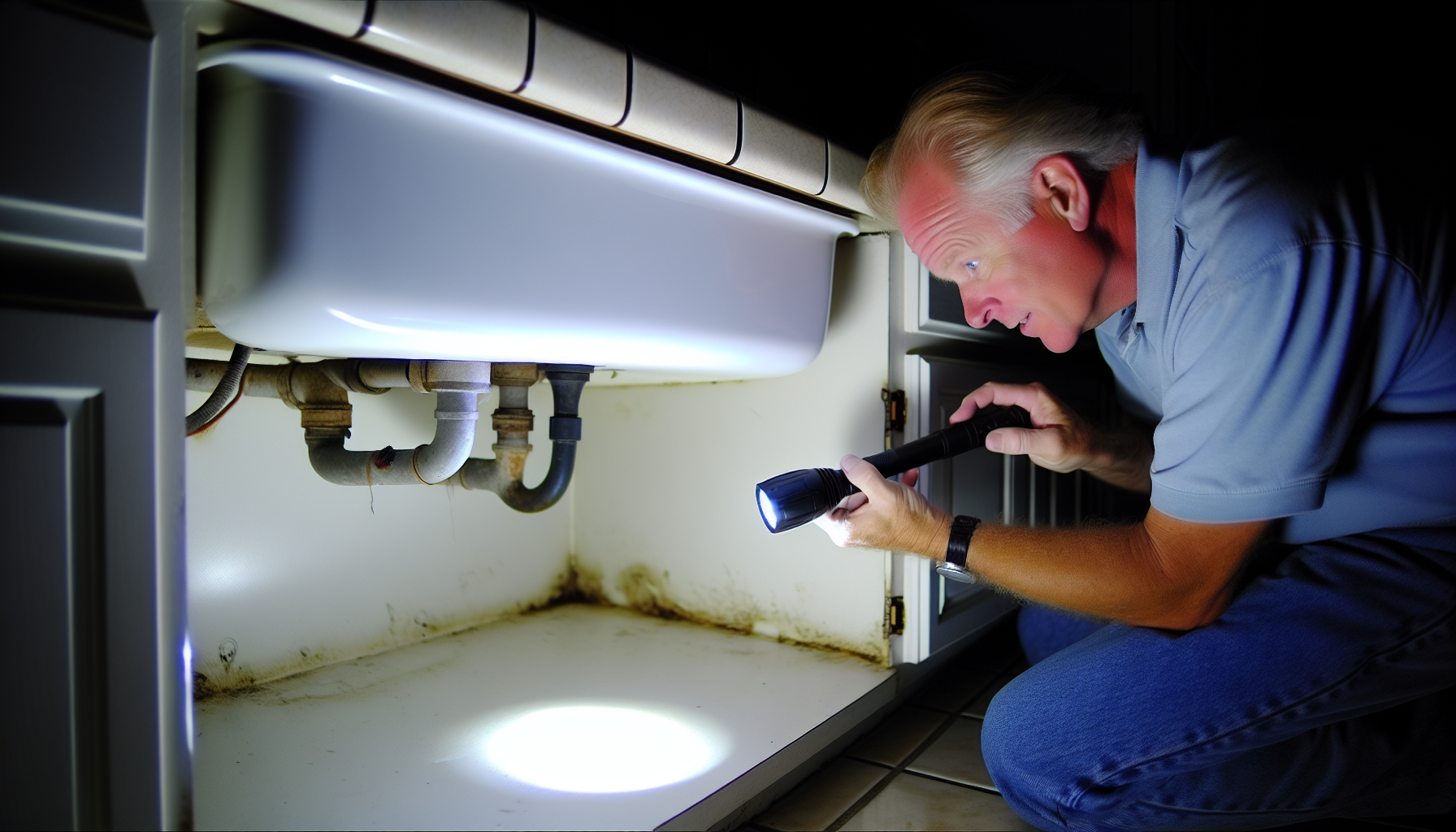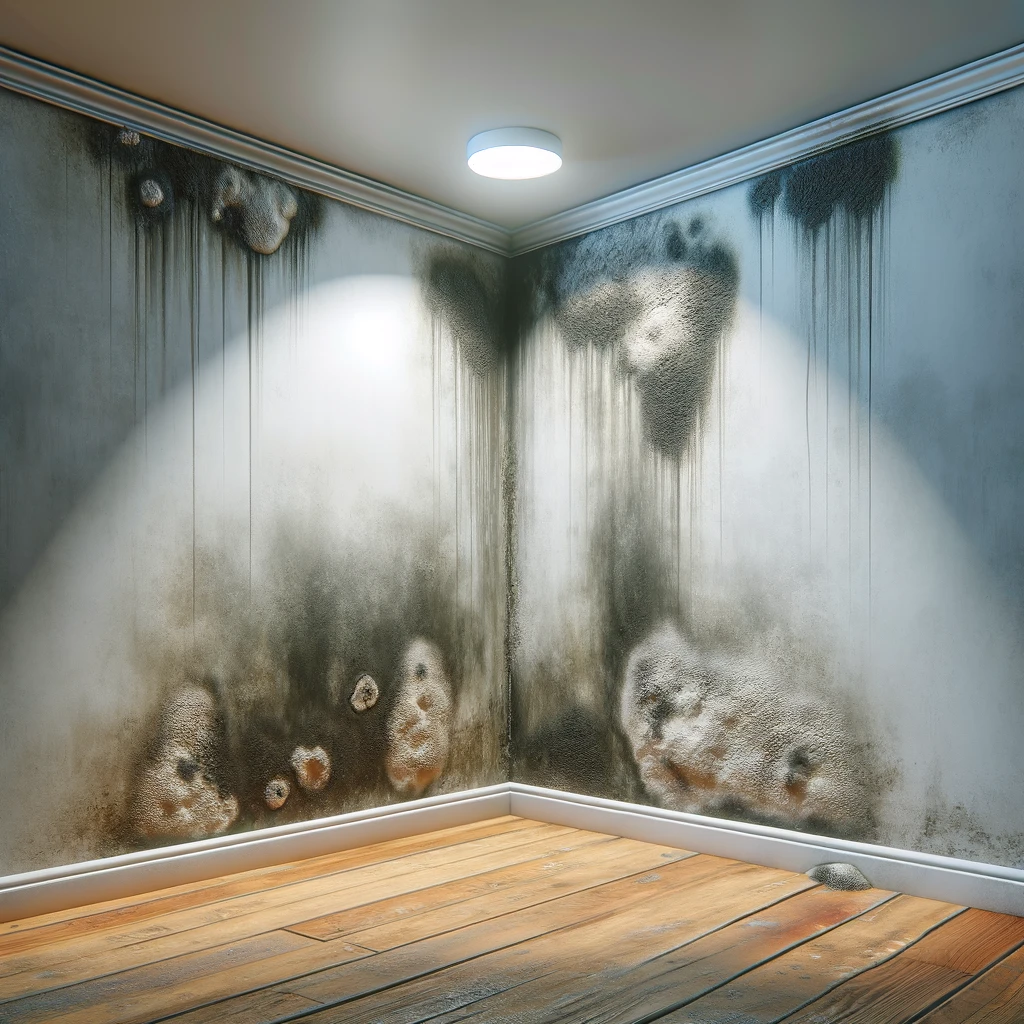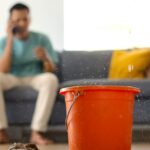Key Takeaways
-
Mold detection following water damage is essential to prevent extensive mold growth, with signs including musty odors, visible mold, discoloration, and allergic symptoms. Moisture meters are critical for finding hidden mold.
-
Health effects from mold exposure are serious, including allergic reactions and respiratory issues, with symptoms like sneezing, red eyes, and wheezing, particularly affecting vulnerable groups such as children and the immunocompromised.
-
Professional mold inspection, testing, and remediation are recommended for accurate detection and safe removal, especially in cases of extensive contamination or when HVAC systems are involved in spreading mold spores.
Detecting Mold Presence Following Water Incidents

When water damage occurs, whether from a roof leak, plumbing failure, or a natural disaster, it creates an environment conducive to mold growth. Mold spores, tiny particles invisible to the naked eye, lie dormant in our homes, awaiting the right conditions to grow. Excess moisture provides the perfect trigger, essentially waking these spores and giving them a chance to colonize, potentially leading to mold damage.
The key to preventing a full-blown mold problem lies in early detection.
Here are some signs to look out for:
-
Musty odors
-
Visible mold growth
-
Water stains or discoloration on walls or ceilings
-
Peeling or bubbling paint or wallpaper
-
Warped or buckled flooring
-
Allergic reactions or respiratory symptoms in occupants
If you notice any of these signs, it’s important to take action immediately to address the water damage and prevent further mold growth.
Spotting mold early on requires a keen sense of observation and an understanding of the telltale signs of mold. These signs can be seen, smelled, and even measured, using tools like moisture meters. But, what exactly should you look for, and how do you identify mold growth? We will examine the specific signs of mold and discuss the usage of a moisture meter for hidden mold detection.
Spotting Telltale Signs of Mold
Mold isn’t always a hidden menace. Sometimes, it’s right in front of your eyes, presenting as black, green, or white spots spreading on your walls, ceilings, and floors. These visible signs of mold are often the first indicator of a problem, especially in the aftermath of water damage. However, it’s important not to confuse mold with water stains, which are typically yellow or brown. While water stains might hint at potential underlying mold growth, they are not mold themselves. Knowing the types of mold can help you identify and address the issue more effectively.
The texture of mold can also provide clues. Mold may feel slimy, fuzzy, or powdery, while water damage often results in bubbling or flaking surfaces. The presence of any of these signs should prompt further investigation. Remember, mold likes to grow in hidden places, so don’t limit your check to visible surfaces. Take a sniff too, as your nose could very well lead you to hidden mold.
The Musty Smell Test
Your sense of smell can be a powerful tool in detecting mold. A musty odor is a key indicator of mold growth after water damage. This characteristic smell is the result of microbial volatile organic compounds released during mold growth. So, if you notice a musty or earthy odor accompanying visible water-related issues, such as stains or peeling materials, it’s likely that mold is growing on the affected surfaces.
However, it’s not just about the presence of an odor. The nature of the smell can also provide clues to the stage of mold growth. Unlike mere water damage, a foul, musty, or rotten smell is indicative of active mold causing the odor. If you notice such a smell, especially following water damage, it would be wise to move to the next step of mold detection – using moisture meters for hidden mold.
Using Moisture Meters for Hidden Mold
Mold isn’t always visible to the naked eye. Sometimes, it lurks behind walls, under flooring or above ceilings, away from our sight. This is where moisture meters come in handy. These devices can help identify areas at risk of mold growth by detecting high moisture levels resulting from water damage. There are two primary types of moisture meter technologies – pin-type meters, which measure moisture by electrical resistance, and pinless meters, which utilize radio frequency signals to detect moisture without damaging the surface.
For materials like wood, a moisture content above 20% indicated by the meter increases the risk for mold development. Regular monitoring of susceptible areas with a moisture meter can help you catch potential mold problems before they get out of hand. Now that we understand how to detect mold let’s move on to where to look for it.
Investigating Common Mold Havens

Mold thrives in dark, damp environments. Certain areas in your home, like your bathroom, basement, or under your sink, provide the perfect haven for mold due to their exposure to moisture and often inadequate ventilation. Mold can also hide in plain sight, growing beneath flooring, within walls, or in poorly ventilated attics or basements due to ceiling leaks.
Knowing where to look is half the battle in preventing mold growth. We will examine three common mold havens in your home: under the sink and plumbing fixtures, the aftermath of roof leaks, and the role of HVAC systems in spreading mold spores.
Under the Sink and Plumbing Fixtures
Under-sink spaces, particularly in kitchens and bathrooms, are common hotspots for mold growth. These areas are frequently exposed to moisture and potential leakage, creating the perfect environment for mold to thrive. Leaky pipes under sinks can create a consistently damp environment that greatly increases the risk of mold development.
Plumbing fixtures and their associated piping are also prevalent sources of water leaks. If unaddressed, these leaks can result in persistent moist conditions, which are ideal for mold growth. Regularly checking for and fixing leaks under sinks and around plumbing fixtures can help prevent the formation of these mold havens.
Roof Leak Aftermath

Roof leaks are another common cause of mold growth. The moisture from the leak creates an ideal environment for mold to thrive, particularly in hidden areas like attics. These hidden areas can become moldy due to the lack of direct sunlight and airflow, which typically help to keep mold at bay.
Attic mold resulting from roof leaks can be categorized as systemic, where moisture buildup causes widespread mold growth, or as limited, confined to the area surrounding the leak. Regardless of the category, it’s important to address roof leaks promptly to prevent the growth and spread of mold.
The Role of HVAC Systems in Spreading Mold Spores
Your HVAC system, which is designed to keep your home comfortable, can become a distribution system for mold spores if not properly maintained and cleaned. Leaks in your HVAC system, such as those from clogged or disconnected drain lines, can provide the moisture mold needs to grow. Moreover, cracked ductwork can lead to mold issues if left unaddressed.
Professional mold inspectors can identify mold in HVAC systems, which might be overlooked by homeowners. Regular maintenance and cleaning of your HVAC system can help prevent the spread of mold spores, keeping your indoor air quality healthy and your home mold-free.
Health Impacts of Post-Water Damage Mold

The presence of mold in your home isn’t just an aesthetic issue or a threat to your property’s structural integrity – it’s a potential health hazard. Exposure to mold can trigger allergies and respiratory problems, such as bronchitis or pneumonia. In severe cases, it can even lead to long-term health issues or life-threatening lung infections.
People who inhale or touch mold or mold spores may experience allergic reactions, which can be immediate or delayed. These reactions can result in symptoms such as:
-
sneezing
-
runny nose
-
red eyes
-
skin rash
In fact, mold exposure can also aggravate asthma and trigger asthma attacks. With these health risks at stake, it’s crucial to take proactive steps in addressing the presence of mold in your home.
Recognizing Symptoms of Mold Exposure
Recognizing the symptoms of mold exposure can help you identify potential mold-related health issues early on. General indicators include:
-
stuffy or runny nose
-
eye irritation
-
sore throat
-
dry cough
-
skin irritation
-
wheezing
-
shortness of breath
-
general malaise
-
difficulty focusing
Unfortunately, these symptoms can be mistaken for common allergy or cold symptoms. However, if you notice these symptoms along with a musty odor in your home or visible mold growth, it’s likely that mold is the culprit. Keep in mind that sensitive individuals may experience more severe reactions, including skin rashes and intensified respiratory symptoms.
Early detection and addressing toxic mold issues promptly can help alleviate these symptoms and prevent further health problems.
Protecting Vulnerable Individuals
Certain individuals are more vulnerable to the health risks associated with mold exposure. This includes:
-
Children
-
The elderly
-
Individuals with compromised immune systems, such as those with HIV, undergoing cancer treatments, or who have had organ transplants
These individuals should avoid any potential exposure to mold as they are more susceptible to mold infections.
Also, individuals with asthma or allergies to mold may experience intensified symptoms and are at an increased risk of asthma attacks, necessitating the avoidance of contact with mold. In fact, living in a moldy home significantly increases the likelihood of children developing asthma. Therefore, protecting these vulnerable individuals from mold exposure is crucial and should be a priority in any mold remediation efforts.
Professional Mold Inspection and Testing
While you can do a lot on your own to detect and address mold in your home, there are times when professional intervention is necessary. A professional mold inspection is crucial for accurate detection and assessment of mold, particularly when mold presence is not immediately obvious. Professionals use various testing methods, including an outdoor baseline assessment, laboratory testing, and specialized tools like moisture meters to detect and identify mold types and the extent of growth.
Upon identifying mold, inspectors guide homeowners on the next steps, and, if necessary, refer them to professional mold remediation services. Inspectors meticulously check for hidden mold growth in areas such as:
-
behind walls
-
in attics
-
basements
-
crawlspaces
-
beneath carpets
-
other high-humidity locations.
We will explore further when to call a professional and what one can anticipate from mold testing procedures.
When to Call a Mold Remediation Company
Engaging a professional mold remediation company promptly after identifying mold can prevent further health issues and mitigate property damage. Mold remediation professionals are equipped with the necessary safety gear and expertise to handle the mold removal process safely and effectively. Calling a mold remediation service is recommended if mold is detected during a professional mold inspection as inspectors may lack the means for proper mold removal.
Due to the hazardous nature of toxic black mold, it is essential to have it removed by professionals. Also, large mold infestations should be addressed by professional remediation services to ensure thorough and safe mold removal. Simply put, when it comes to significant mold problems, getting professional help is the best bet for your health and your home’s well-being.
Understanding Mold Testing Procedures
Professional mold testing procedures involve a series of steps designed to accurately identify the presence and extent of mold in your home. Prior to testing, homeowners should cease use of humidifiers, dehumidifiers, air purifiers, and HVAC systems to avoid distorting results. Actions such as cleaning, disinfecting, or mowing the lawn should be avoided before mold testing as they can impact the baseline measurement of mold spores indoors.
The testing itself involves comparing indoor mold spore levels to the outdoor spore concentration to spot any unusual indoor mold growth. Air sampling and surface sampling are common tests that mold inspectors use to determine the mold spore concentration in the air and identify mold types on surfaces. Laboratory analysis of mold samples usually takes 24 to 48 hours to complete, providing detailed information about the type and presence of mold.
Upon identifying mold types, professionals determine the most effective cleaning agents to remediate the specific mold found in the home.
DIY vs. Professional Mold Removal Strategies
While professional mold remediation is the safest and most effective way to address significant mold problems, smaller infestations can sometimes be managed with DIY mold removal methods. DIY strategies include using natural substances like:
-
borax
-
tea tree oil
-
baking soda
-
vinegar
-
hydrogen peroxide
These substances are preferred over bleach as bleach may only lighten mold without removing it. It’s crucial, however, to wear protective gear such as goggles, a face mask, gloves, and protective clothing during DIY mold cleanup to prevent inhalation or contact with airborne mold spores.
While DIY methods can be effective for small areas, they may not be sufficient for larger infestations or for removing mold from challenging surfaces such as drywall and insulation. Professional mold removal offers advanced techniques and specialized equipment, making it possible to eradicate mold from these challenging surfaces. We will explore further into safe DIY mold cleaning tips and situations that necessitate hiring a restoration services specialist.
Safe DIY Mold Cleaning Tips
If you’re dealing with a small mold problem and decide to tackle it yourself, safety should be your top priority. Here are some steps to follow:
-
Always wear protective gear, such as N95 masks or higher-level respirators, to prevent mold exposure during cleaning.
-
For non-porous surfaces, a mixture of dish soap, vinegar, and water can effectively remove mold.
-
On porous surfaces, like drywall, early-stage mold can be treated with commercial mold removal products.
Remember, DIY mold removal should only be undertaken for small affected areas less than 10 square feet. Any mold-infected materials should be removed and sealed in heavy-duty garbage bags before disposal. If the mold issue persists or reappears after your DIY cleanup, it’s time to call in a professional.
When to Hire a Restoration Services Specialist
Professional restoration services should be sought for mold-affected areas exceeding 10 square feet. Larger areas of mold infestation pose a significant risk to your health and property, necessitating professional help. Persistent mold on porous materials, such as carpets, that remains after scrubbing or reappears post-cleanup also calls for professional assistance.
Professional companies possess the necessary equipment and expertise to handle large mold problems effectively. When choosing a mold remediation company, consider the following:
-
Seek at least three quotes
-
Verify the company’s reputation and any potential hidden fees
-
Request a detailed ‘Scope of Work’ from the remediation company to ensure transparency throughout the process.
Preventive Measures to Thwart Mold Growth

Prevention is undoubtedly the best strategy when it comes to mold. By now, we know that mold thrives in damp, humid environments. Therefore, to prevent mold growth, it is important to:
-
Maintain low humidity levels in your home
-
Ensure good ventilation to allow for air circulation
-
Take fast action to address any water spots or leaks by drying the area completely and fixing the source of the water.
By following these steps, you can effectively prevent mold growth in your home.
Remember, before any mold removal, it’s important to:
-
Identify and fix the water source to avoid ongoing moisture issues and further mold growth.
-
Keep high-risk areas, such as under sinks, dry and repair any leaks promptly to prevent mold development.
-
Apply mold inhibitors to paints and other solutions to help prevent mold in areas prone to moisture.
We will further explore how to maintain low humidity levels and ensure good ventilation.
Maintaining Low Humidity Levels
The Environmental Protection Agency recommends maintaining indoor humidity levels between 30% to 50% to prevent mold growth. Humidity levels exceeding 60% can promote mold and mildew growth. To reduce indoor humidity, you can:
-
Improve ventilation
-
Use dehumidifiers
-
Quickly dry wet areas
-
Insulate the home effectively
-
Maintain plumbing
-
Utilize moisture-absorbers like charcoal.
Indoor activities such as cooking, dishwashing, laundry, and long showers increase humidity. Using vented exhaust fans can mitigate moisture accumulation. Also, sealing structural cracks and gaps in exterior walls and foundations helps prevent outdoor moisture from infiltrating indoor living spaces. After cleaning areas prone to moisture, using fans or dehumidifiers to dry those areas thoroughly is essential to prevent mold from regrowing.
Ensuring Good Ventilation
To facilitate better air circulation, consider employing the following strategies:
-
Use fans and open windows to disperse water vapor
-
Use additional ventilation fans or portable dehumidifiers in moist areas
-
Maintain your HVAC system with annual inspections and routine air filter changes
-
Install a dehumidifier, especially in areas prone to dampness such as basements or crawl spaces, to ensure proper airflow and humidity control.
Ensure that your bathroom and kitchen fans vent directly to the outside of your home to effectively remove moisture and prevent it from circulating indoors. Here are some tips to follow:
-
Regularly inspect and consider replacing bathroom fans that are over 15 years old.
-
Ensure that exhaust fan ductwork is free from leaks, separations, or blockages.
-
For appliances such as clothes dryers, use rigid metal ductwork to minimize bends and ensure proper connection to the exterior vent hood.
-
Regularly clean lint buildup to maintain airflow.
Place houseplants in areas with good ventilation or move them outside to prevent increased humidity inside the home, and opt to dry clothes outdoors rather than indoors.
Summary
To sum up, mold is more than just a nuisance. It’s a serious problem that can cause health issues and structural damage to your home. The good news is that with keen observation, prompt action, and the right preventive measures, it’s possible to keep your home mold-free. Remember, early detection is key. Be vigilant, especially after water damage, and don’t hesitate to seek professional help if needed.
Mold is not something to be taken lightly, but it’s also not a cause for panic. With knowledge on your side, you can address and prevent mold effectively, ensuring a healthy and safe environment for you and your loved ones. Remember, a mold-free home is more than just clean – it’s healthy, safe, and comfortable.
Frequently Asked Questions
How likely is mold after water damage?
Mold is likely to grow quickly after water damage, especially when moisture is not handled promptly and properly, which can lead to a significant mold infestation.
What are the symptoms of mold from water damage?
Yes, mold from water damage can cause health problems. Watch out for symptoms like coughing, sneezing, and throat irritation.
How do you tell if mold is making you sick?
If you suspect mold is making you sick, look out for symptoms such as nausea, vomiting, abdominal pain, headache, fever, and fatigue, and contact your doctor immediately.
What are the signs of mold in my home?
If you notice visible spots in black, green, or white, along with a musty odor and symptoms like stuffy nose or skin rash, then you might have mold in your home. Take necessary steps to address this issue.
Where can mold grow in my home?
Mold can grow in damp, dark environments like under sinks, in bathrooms, basements, and areas affected by leaks such as attics and walls. Keep an eye on these areas to prevent mold growth.



